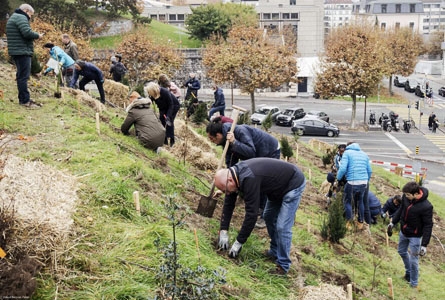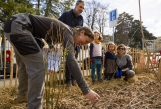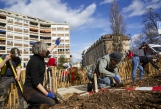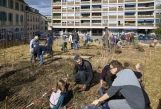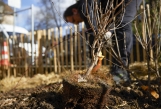When it joined the “Trees in Cities” campaign of the United Nations Economic Commission for Europe, the City of Geneva aimed to plant 900 trees by April 2022. To underline its commitment to responding to the climate emergency and mitigate the lack of oases of freshness, it has also just planted the first two Miyawaki micro-forests in Switzerland.
The planting season has begun: it’s going to be bountiful and rich in diversity. 900 trees will be added to the more than 40,000 specimens already on public land to make up for the 300 that had to be removed or cut down last season either because of the bad weather or for health reasons.
The species and sizes are carefully chosen by the Parks and Gardens Service (SEVE) to fit in with the landscape where they are being planted. In addition to storing carbon and absorbing pollutants such as sulphur dioxide and nitrogen dioxide, increasing the wooded area is a way of limiting ground warming, freshening the air thanks to evapotranspiration in summer, protecting the soil and limiting erosion by intercepting rainwater.
A greener city
This winter, the parks along the northern shore of the lake (Mon Repos, Moynier, Perle du Lac, William Rappard, Barton) will be given an additional 180 trees. On the other side of the lake, in the parks at La Grange and Eaux-Vives, 150 will be added to the arboreal heritage, which suffered from the bad weather in summer 2020.
Nor are streets being neglected: SEVE will be planting five green oaks on rue du Grand-Pré. The rue Saint-Léger is being adapted to receive eight sophoras from Japan, and on the Quai Capo-d’Istria 11 honey locust trees will be added. The trees have been chosen for their resistance to drought and high temperatures.
Public spaces will have a great diversity of species while maintaining a balance between indigenous and exotic types, with many varieties of oak, field maple and wild service trees, alongside exotics like the Chinese pistachio, the hop hornbeam, the oriental sweetgum and the goldenrain tree. Maps of plantings and trees cut down or damaged can be found at "Tree management".
Public participation in planting two Miyawaki forests
The first two Miyawaki microforests in Switzerland were planted with public help in November in the les Charmilles industrial area (ZIC) and on the butte Ferdinand-Hodler, in partnership with the company Forêt B. Developed by Japanese botanist Akira Miyawaki, this method seeks to imitate what happens in primary natural forests, and so helps biodiversity in the city. Based on density and a balance of species, it is equally effective at combating heat islands, cleaning the air and supporting the resilience of indigenous species, which are increasingly vulnerable to global warming and urban pressure.
Around 110 local residents and 20 students at the Pre-vocational Training Centre (CFPP) and on the ACCESS II programme took part over two weekends in planting more than 1,200 plants over some 540m2. This group of volunteers will also be involved in maintaining the forests. In addition, at the parc La Grange a forestation campaign is planned to add a hundred or so plants with naked roots to reforest certain areas. “The various campaigns we are running aim to protect the climate and biodiversity while providing an opportunity to get involved in improving our living conditions.
Public participation is a new venture we are exploring with SEVE and which we are keen to develop. The aim is also to make the city more resilient and take part in the collective effort to reduce global warming,” said Alfonso Gomez, Executive Councillor for the Environment and Sustainable Development.
A UN campaign to support trees
Finally, the City of Geneva is delighted to announce it is taking part in "Trees in cities Challenge", a global campaign launched by the United Nations Economic Commission for Europe (UNECE) in 2019 that encourages cities to protect, develop and sustainably manage trees and urban forests. The United Nations General Assembly declared that 2021-2030 would be the decade of restoring ecosystems and called for global action to protect and restore ecosystems. Cities have a particularly important role to play.
They are responsible for about 75% of global carbon dioxide emissions and are particularly vulnerable to the effects of climate change (flooding, drought, increased air pollution, etc.). By joining this community of proponents for change, the municipality is putting in place a network for sharing experience and best practice and committing to boost its resilience. As with the micro-forests, Geneva is the first city in Switzerland to join this UN initiative.
Contact
Vaucher Anna
Département des finances, de l'environnement et du logement
Collaboratrice personnelle
5, rue de l'Hôtel-de-Ville
1204
Genève
Suisse
Article modifié le 27.03.2023 à 12:28

